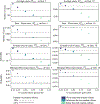Temporal and Probabilistic Comparisons of Epidemic Interventions
- PMID: 37857996
- PMCID: PMC11216031
- DOI: 10.1007/s11538-023-01220-w
Temporal and Probabilistic Comparisons of Epidemic Interventions
Abstract
Forecasting disease spread is a critical tool to help public health officials design and plan public health interventions. However, the expected future state of an epidemic is not necessarily well defined as disease spread is inherently stochastic, contact patterns within a population are heterogeneous, and behaviors change. In this work, we use time-dependent probability generating functions (PGFs) to capture these characteristics by modeling a stochastic branching process of the spread of a disease over a network of contacts in which public health interventions are introduced over time. To achieve this, we define a general transmissibility equation to account for varying transmission rates (e.g. masking), recovery rates (e.g. treatment), contact patterns (e.g. social distancing) and percentage of the population immunized (e.g. vaccination). The resulting framework allows for a temporal and probabilistic analysis of an intervention's impact on disease spread, which match continuous-time stochastic simulations that are much more computationally expensive. To aid policy making, we then define several metrics over which temporal and probabilistic intervention forecasts can be compared: Looking at the expected number of cases and the worst-case scenario over time, as well as the probability of reaching a critical level of cases and of not seeing any improvement following an intervention. Given that epidemics do not always follow their average expected trajectories and that the underlying dynamics can change over time, our work paves the way for more detailed short-term forecasts of disease spread and more informed comparison of intervention strategies.
Keywords: Branching process; Disease modeling; Forecasting; Networks; Stochastic process.
© 2023. The Author(s), under exclusive licence to Society for Mathematical Biology.
Figures





Update of
-
Temporal and probabilistic comparisons of epidemic interventions.ArXiv [Preprint]. 2024 Jan 18:arXiv:2302.03210v2. ArXiv. 2024. Update in: Bull Math Biol. 2023 Oct 19;85(12):118. doi: 10.1007/s11538-023-01220-w. PMID: 36798454 Free PMC article. Updated. Preprint.
References
-
- Allen A (2023) andrea-allen/pgf-networks. GitHub. Retrieved from https://github.com/andrea-allen/pgf-networks
-
- Allen A (2021) andrea-allen/epintervene. Retrieved from 10.5281/zenodo.5076514 - DOI
-
- Allen AJ, Boudreau MC, Roberts NJ, Allard A, Hébert-Dufresne L (2022) Predicting the diversity of early epidemic spread on networks. Phys Rev Res 4:013123. 10.1103/PhysRevResearch.4.013123 - DOI
-
- Althouse BM, Wallace B, Case B, Scarpino SV, Allard A, Berdahl AM, Hébert-Dufresne L (2020) The unintended consequences of inconsistent pandemic control policies (Preprint No. medRxiv:2020.08.21.20179473)
Publication types
MeSH terms
Grants and funding
LinkOut - more resources
Full Text Sources

